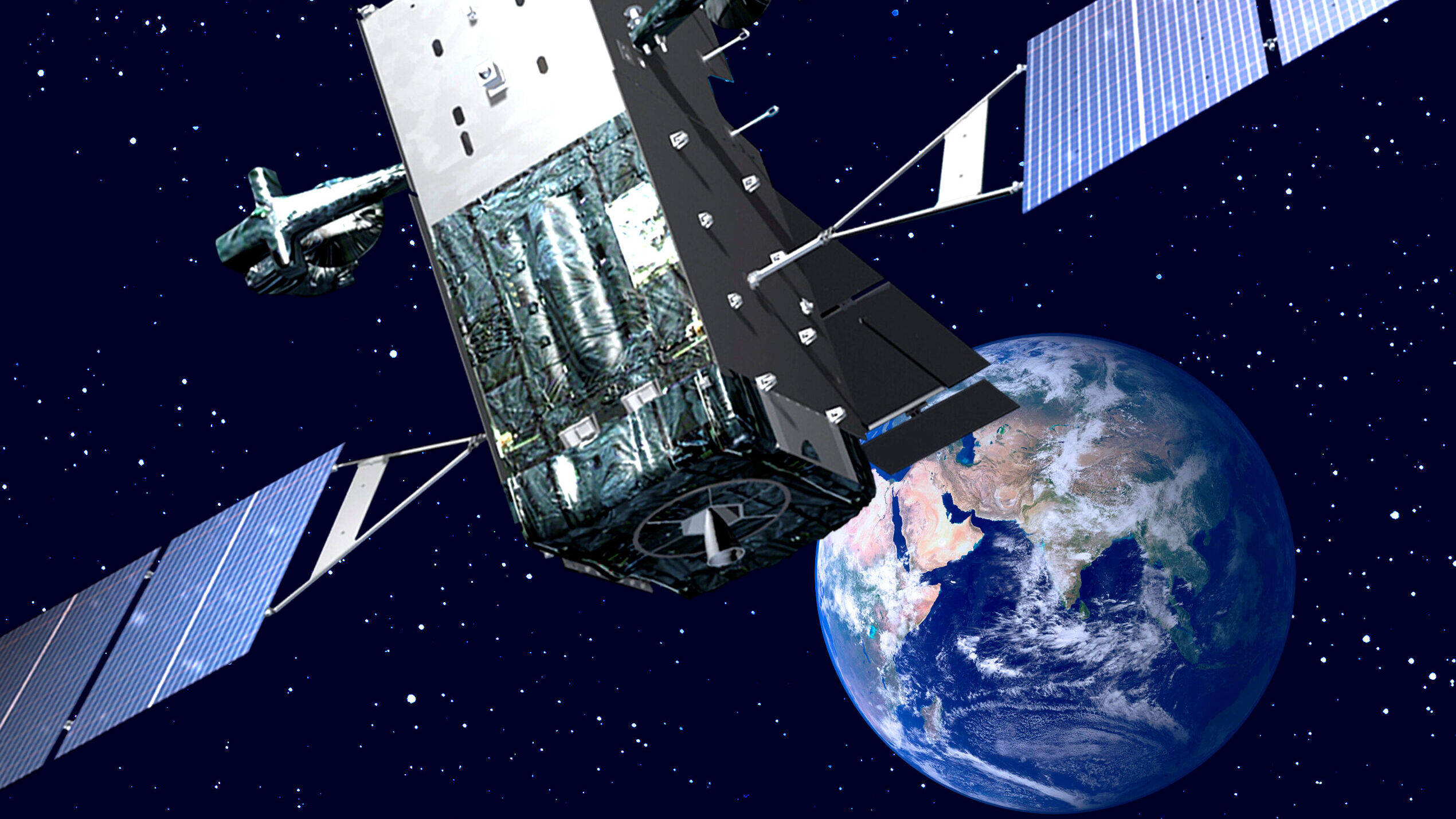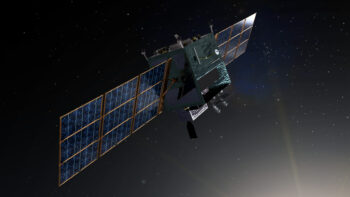
Space Based Infrared System (SBIRS) satellite, USAF image
WASHINGTON: The missile warning and tracking “force design” developed by the Space Warfighting Analysis Center (SWAC) calls for satellites in Medium Earth Orbit (MEO) to provide backup to currently planned constellations, Derek Tournear, director of the Space Development Agency (SDA) said today.
While details of the SWAC plan remain classified, Tournear explained the idea is that MEO sats will increase the resiliency of the overall missile warning/tracking architecture by augmenting capability provided by the Next Generation Overhead Persistent Infrared (Next-Gen OPIR) constellation in Geosynchronous Orbit (GEO) and SDA’s own planned missile tracking satellites in Low Earth Orbit (LEO) that are part of its planned seven-layer National Defense Space Architecture.
“The SWAC study has said the future OPIR architecture for missile warning/missile tracking should be this kind of a hybrid layer,” he told the Mitchell Institute’s Schriever Spacepower Forum. “We should have satellites that are working at GEO, the Next-Gen OPIR GEO satellites; we should have the proliferated-LEO to be able to give us the sensitivity we need for hypersonic glide vehicle tracking and give us that full global coverage; and then we should also have some satellites at MEO to be able to add in resiliency in the event that one or multiple layers are attacked.”
Breaking Defense first reported that Space Force was considering MEO for a future set of Next-Gen OPIR satellites this past July. At the time, a service official said in an interview that 18-month contracts were signed in April and May with Raytheon, for $29 million, and Boeing’s Millennium Space, $28.1 million, to provide “prototypes.”
SDA Tracking Layer optimized to keep tabs on low-flying, maneuvering hypersonic missiles. (SDA graphic)
The data from all the various missile warning/tracking satellites would then be fused on the ground, Tournear said.
“That’s one of the things that that [Space Systems Command] is tasked with: making sure that that systems-of-systems approach of tying all of these systems together into that joint OPIR ground can actually work and then disseminate those data,” he said.
He explained that as SDA’s Tracking Layer satellites mature every two years or so under the agency’s spiral acquisition strategy, the idea is that eventually they would be able to link directly to Next-Gen OPIR birds, with all the data fused on-board the agency’s Transport Layer data relay sats. But for the foreseeable future that won’t be the case.
“Ideally, you would want to be able to have connectivity from any and all OPIR systems to the Transport Layer so they could be fused on board, but … Next-Gen OPIR … it’s a long development program,” he said. “We don’t want to disturb that by trying to add in that connectivity to the Transport Layer at this point. We’re going to do that all through the ground.”
The various missile warning/tracking satellites all will downlink into a system called the JOG, for Joint OPIR Ground, Tournear said. That system is currently used by the Missile Defense Agency (MDA) and SSC for collecting missile warning data from legacy satellites and the Space-Based Infrared System (SBIRS) satellites and fuse it into “three dimensional tracks” showing adversary missile trajectories.
“Once those tracks are fused, they are then disseminated out typically over UHF or other Link 16 networks, then to weapons platforms,” he added. Space Force now plans to launch the sixth and last of the SBIRS satellites sometime this year.
The first of the Next-Gen OPIR satellites is expected to launch in 2025: one of the three GEO sats in the constellation being built by Lockheed Martin. Two satellites in an elliptical orbit over the Earth’s poles, being built by Northrop Grumman, will round out the constellation.
However, the development program — budgeted at a whopping $14.4 billion through 2025 — is facing criticism from all four congressional committees with oversight powers. Lawmakers in particular are upset about a lack of transparency in the highly classified effort and warnings from the Government Accountability Office that it is sliding off track.
SDA’s first set of operational Tracking Layer satellites is also planned for a 2025 launch, Tournear said. SDA intends to solicit industry proposals for 28 “Tranche 1” Tracking Layer early this year, he added.
The Tracking Layer involves pairing SDA’s new a wide-field of view infrared sensor and MDA’s new medium-field of view Hypersonic and Ballistic Space Sensor (HBTSS) to track both traditional ballistic missiles and the harder-to-see hypersonic cruise missiles in flight.
MDA awarded L3Harris a $121 million contract on Jan. 14, 2021 and Northrop Grumman $155 million on Jan. 22, 2021 for each to develop a sat-based prototype medium field-of-view sensor targeted specifically at keeping tabs on hypersonic missiles flying fast and low.
Before that, however, SDA in October 2020 tapped L3Harris and SpaceX to build a first set of Tracking Layer satellites designed test out new capabilities, as part of its “Tranche 0” to demonstration initial capability. SpaceX won $149 million and L3Harris $194 million to each build four satellites to detect ballistic, cruise and hypersonic missiles using a wide field of view IR sensor. Those satellites are expected to launch this year.
In addition, SDA is hoping to release a request for proposals for its Operations and Integration layer —”essentially the ground layer that ties all of our constellations together,” he explained — as early as next week. An award is expected early this year, Tournear said.
Space Force gets vote on IC Commercial Space Council
The status change should give the Space Force more weight in debate about how to share acquisition authority for commercial intelligence, surveillance and reconnaissance.



























